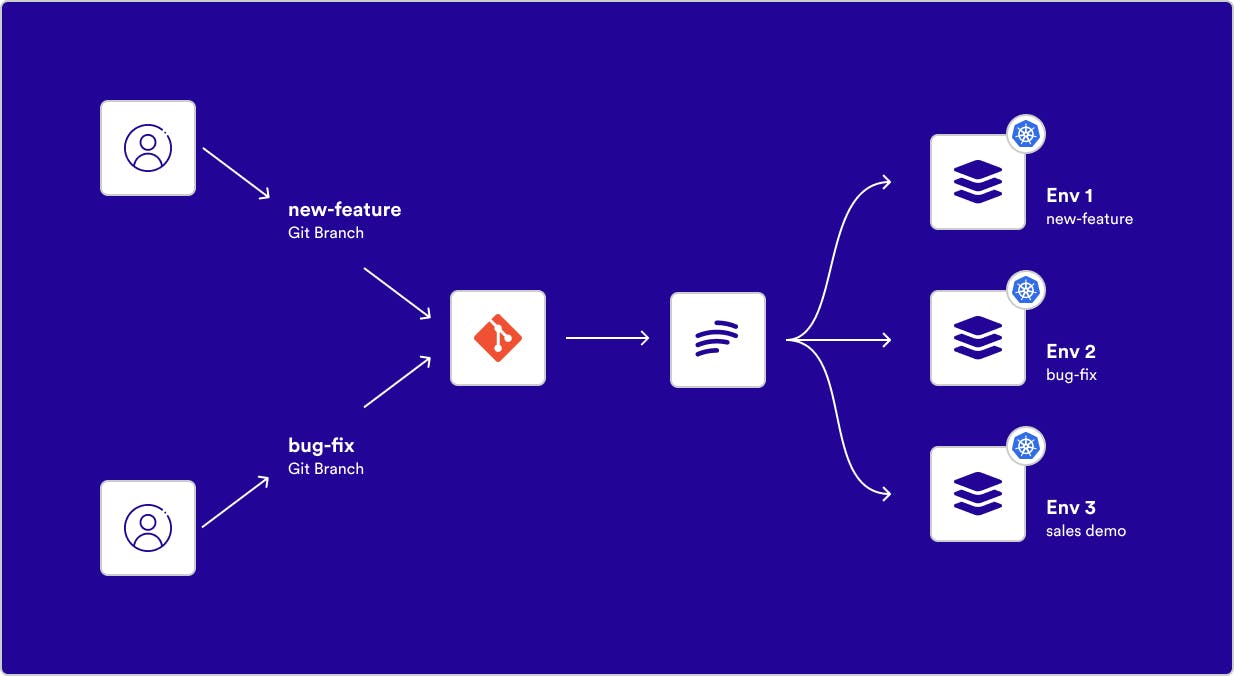The IT industry is changing every day with new trends and developments. Because of this, a major shift has occurred towards test environments, driven entirely by automation and self-service. This is where Environment as a Service (EaaS) comes in, supporting faster innovation and eliminating any environment bottlenecks.
In this article, we will talk about what Environment as a Service is, some use cases, the main benefits of EaaS, and why Bunnyshell is the right solution for you.
What Is Environment as a Service?
EaaS is a natural extension of Infrastructure as a Service (IaaS). But besides your usual hardware and base software, EaaS also includes all of your code and settings, plus the infrastructure and software to run your application in an isolated environment.
Since EaaS is a service where the application and environment run together while undergoing version control, it uses automation to perform server configuration for specific applications. You essentially describe your application to the system and the EaaS platform does the rest for you. It also provides a great testing environment - it’s an all-in-one application environment.

Use Cases for Environment as a Service
Environments can be used for:
- Sales Demos
- Performance testing
- QA
- Large software and data migrations
- Production, and more
Aside from production, the environments are ephemeral. This means that they come and go based on your particular Systems Development Life Cycle (SDLC). Development teams use these environments to collaborate and have feedback at various points of the process. This makes the entire process more streamlined, less costly, and faster.
Test Environments
A testing environment is very specific and involves creating a space to perform test executions of component parts. The test includes the software and hardware you’re running it on. This kind of environment is something you develop and create to test a certain function in a specific way. Everything you build, be it a component or app, has fundamental requirements needed for testing. Therefore, your component under test dictates the environment, not the other way around.
Staging Environments
The staging environment isa setup that replicates your production environment. There is no difference between the staging environment and your final product. Since it’s an identical replica of your product, you can think of it as a safe space, a space where you can throw everything together to find out how it works. Essentially, it’s the ultimate quality assurance test, allowing you to get as close to the real thing as possible.
Proof of Concept Demos
You can deploy environments to work as proof of concept demos that can then be sent to stakeholders directly. Collaboration is a big part of ephemeral environments, allowing teams of developers, engineers, designers, and product managers to see changes and provide feedback often. Getting feedback early on in the process and finding quality issues reduces costly rework.
Feedback drives your development team in the right direction to refine your project, validate that it has demand, and that it can solve the problems it was created to address. Since POCs are detail-oriented and customizable, a successful one may require you to change your priorities, goals, staff, and budget as discoveries are made. But when stakeholders become a part of the process, rework is therefore reduced. Stakeholders can see progress while code is developed with URLs to the environment. And since EaaS is in the cloud, it can be accessed from anywhere, by anyone.
Online Training Environments
Online training environments are impactful especially because these environments are always available online and can be used for new hires or team members. Participants can access sessions from any location on any device. This level of accessibility makes learning easier for business partners and gives consumers a better impression of your product.
The environment is always available to users within the parameters that you set, so they can engage with the platform at their own pace. Additionally, the EaaS model is scalable. You only pay for the resources you need, so you can expect lower costs since there is no need for travel or physical set-up time. You are also able to update and modify these environments from anywhere so there is no need for participants to keep track of or install new versions of the software.
The Main Benefits of Environment as a Service
Test Environments play a vital role in the innovation and development of a business. That’s why implementing an EaaS can change the whole trajectory of your business. The benefits of Environment as a Service include:
- Cost - entire costs that go into support and maintenance of applications are greatly reduced.
- Less internal development time - DevOps teams are tasked with setting up application environments that support testing, rapid development, and deployment, which is a tedious task and hard to scale. Instead, EaaS allows environments to be delivered to you, making it easy to scale your application.
- Minimal use of tools - minimizing the use of underutilized tools will enable you to use your resources efficiently.
- Low cycle time - when the cycle time of a project is lower, specific software features are available earlier.
- Faster results - since you can expect results sooner, you get to see the final product, allowing consumers to view the application.
- There is no need for extensive redesigning - you achieve rapid development of the program and final deployment and avoid extensive redesign.
- Flexibility - you have complete flexibility in making any future changes to the application.
- More benefits of EaaS here
What’s the Business Value of Environment as a Service?
In today’s modern cloud world, apps run in complex environments as teams use different orchestration tools to manage and automate them. The more apps you have, with multiple versions, the more difficult managing them becomes. This is time-consuming and keeps DevOps teams constantly busy, leading to duplications, errors, and delays that affect your performance and bottom line. EaaS simplifies all of these complexities.
EaaS integrates with all orchestration toolchains, providing a consistent way to manage all of your environments. It allows applications to run across multiple cloud or data center platforms at the click of a button, and you don’t need additional language either. All deployments and changes can be done automatically, updating all relevant apps instantly. This ultimately saves you time, money, and prevents errors for total compliance.
EaaS Is the Future
For businesses and companies looking to improve their development cycles, EaaS is a logical solution. It provides a great testing environment to release the best version of your product and allows you to move as fast as possible without sacrificing quality. Not being able to produce isolated environments will hold your business back in more ways than one.
At Bunnyshell, we offer you the EaaS platform you need to cut downtime and deliver reliable applications and services at high velocity. EaaS is a great future-proof alternative to developing an internal testing environment as it will save you and your DevOps team time and money and improve product quality. Let’s make bottlenecking a thing of the past and EaaS a thing of the future.
Enable High Velocity Development
Breakaway from the inability to quickly deploy isolated environments of any specification.
